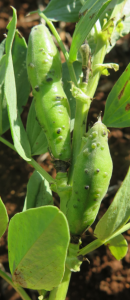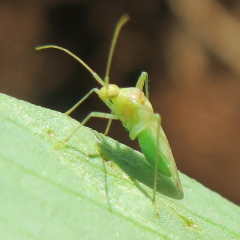In 2019, many of the faba bean crops have growths on pods. There has been much debate over the years about the cause/s of the lumps seen on the pods of faba beans; with some attributing it to thrips, or more recently to green mirid feeding.
The growths are called oedema or intumescences, and are caused when the uptake of water by the plant exceeds the rate of transpiration. This results in the build-up of water under the epidermis (skin) which appear as small protuberances which grow, and eventually burst. The conditions that promote oedema development are high humidity and low light, specifically low UVB. High soil moisture and cool night temperatures are also associated with the development of oedema.
Irrigation and shading of lower pods may provide the conditions that promote the development of oedema in faba beans.
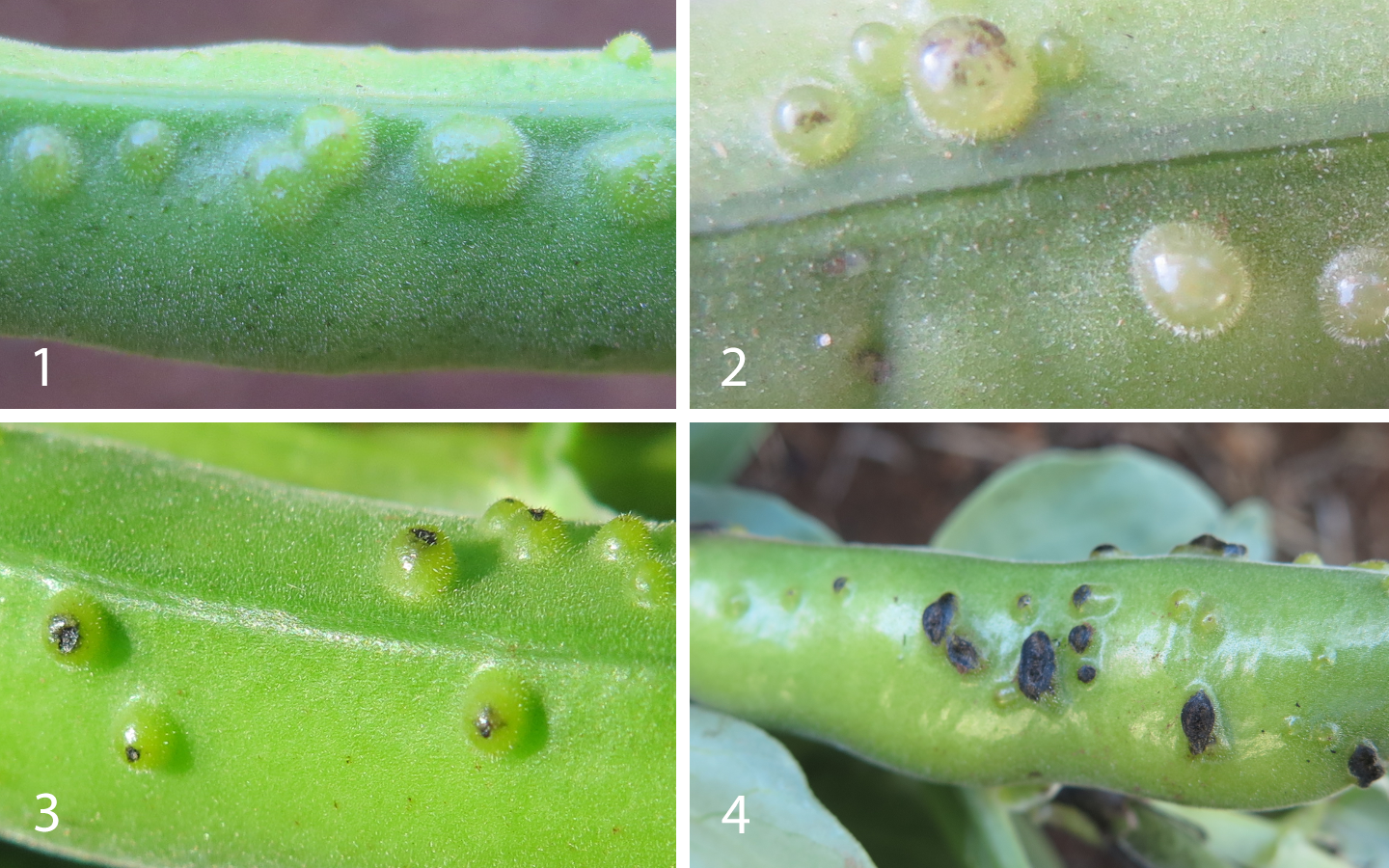
Stages of oedema development on faba bean pods. Raised lumps develop under the ‘skin’, eventually bursting and leaving a dark area (scab) on the surface of the pod.
Oedema are well known from protected horticulture—plants grown in glasshouses and igloos are highly susceptible because of the high humidity and low UVB conditions. Oedema on pods is not as well documented as oedema on leaves, however in the literature, there are records of oedema occurring on stems, pods and roots of a number of crops including peas, potatoes and tomatoes.
In the US, trials have shown that increasing calcium concentrations in plants can significantly decrease the incidence of oedema on leaves in some varieties of potato (Schabow & Palta, 2019), indicating that there may be a nutritional and/or varietal aspect to oedema development.
How do we know oedema are not caused by green mirid feeding?
Queensland’s Department of Agriculture and Fisheries (DAF) Field Crop Entomology team has undertaken replicated trials to establish whether green mirids can damage developing and maturing faba bean seed (see the Beatsheet article on this research). These trials involved caging adult mirids directly on pods for a week and assessing their impact in terms of the appearance of the pods, presence of warty growths inside the pod and impact on the size and quality of resulting seed. In these trials we saw no oedema develop on any of the pods exposed to green mirid feeding.
Mirid feeding on faba beans typically results in very little external damage, but in some instances you will see the development of warty growth and/or a secondary bacterial/fungal infection on the internal pod wall. The images below show a pod with both oedema and green mirid feeding damage and illustrate the difference between the appearance of mirid feeding sites and oedema on the external pod surface.
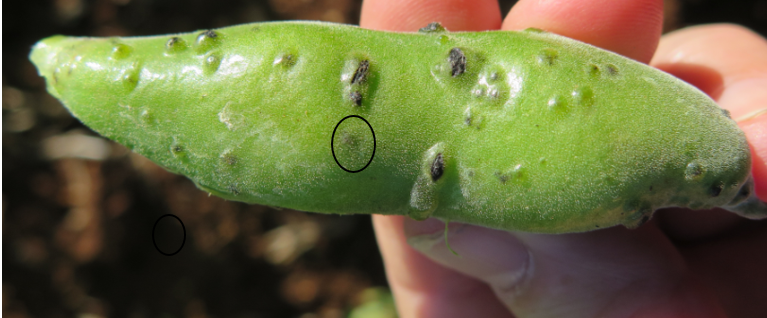
1) The external pod showing oedema and mirid damage (in the black circle). Mirid feeding has not produced a raised lump on the external pod surface.
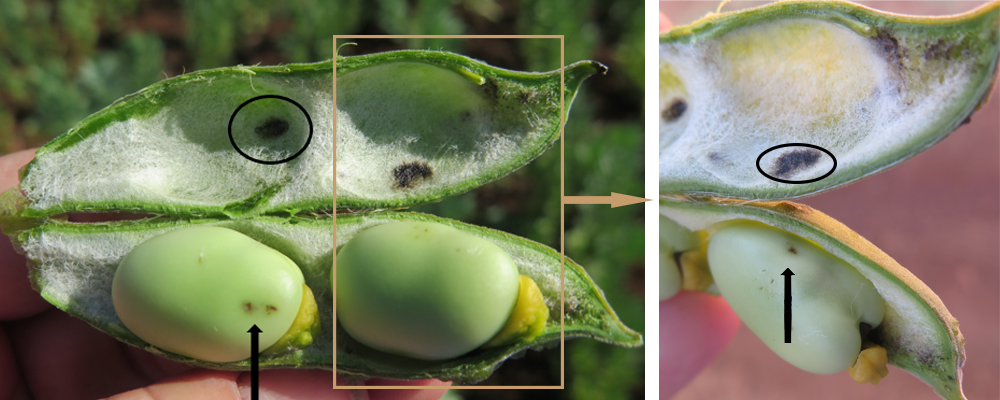
2) The same pod opened up showing the internal symptoms of mirid feeding—black areas as a result of entry by bacteria/fungi through the feeding wound. The damage to the pod corresponds to the damage to the seed within the pod (black arrow points at the ‘sting’ marks on the seed).
Is there any evidence that oedema is caused by thrips?
Some years ago, a NSW DPI Entomologist undertook trials to establish the role of thrips in the development of oedema. A link could not be clearly established. This doesn’t mean thrips are definitely not involved, and it is has been suggested that the oedema may be initiated very early in pod development when thrips are present in flowers. No trial work has been undertaken to investigate this relationship.
Where to from here?
It is important to determine whether oedema alone are associated with the development of discolouration on the seed coat, and potential discounts/downgrades.
Late in the season, if pods have both oedema and seed staining, it is difficult to pinpoint conclusively the cause of the staining, as a lot may have happened in the crop during the season. A causal agent completely separate from the development of oedema could have initiated the staining earlier in the season—thrips, mirids, disease or something else. Even if crop monitoring has been regular and comprehensive, there can be a significant time lag between insect feeding and the appearance of symptoms on pods. For example, the evidence of earlier feeding by mirids on the filling seed does not become visible (as marking on the seed coat) until the seed is maturing. The same might be true for thrips present at flowering and very early pod development.
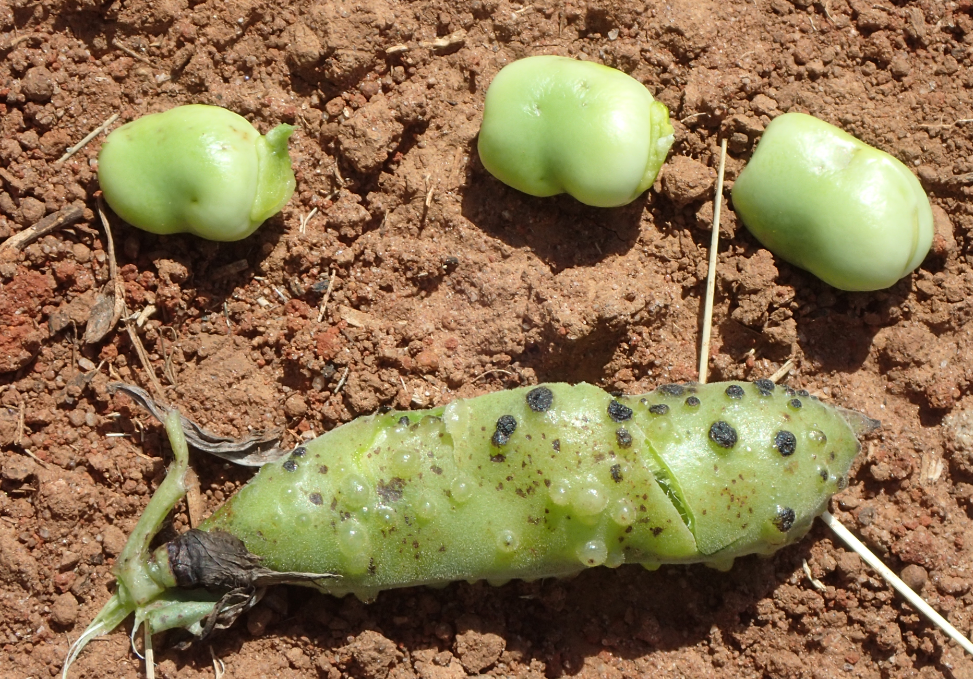
The seeds from this pod with numerous oedema are marked, but that doesn’t necessarily mean that the marking is caused by the oedema (Photo: Joop van Leur, NSW DPI. Grafton 2019). NSW DPI have plans for future investigative trials involving mirids on faba beans.
If oedema are determined to be clearly associated with seed staining, then it will be important to understand how they occur and develop management strategies to minimise their impact.
References
Hartman J & Enshenaur B. 2004. Oedema. University of Kentucky cooperative extension service. 1pp.
Schabow JE & Palta JP. 2019. Intumescence injury in the leaves of Russet Burbank potato plants is mitigated by calcium nutrition. American Journal of Potato Research. 96: 6-12.

